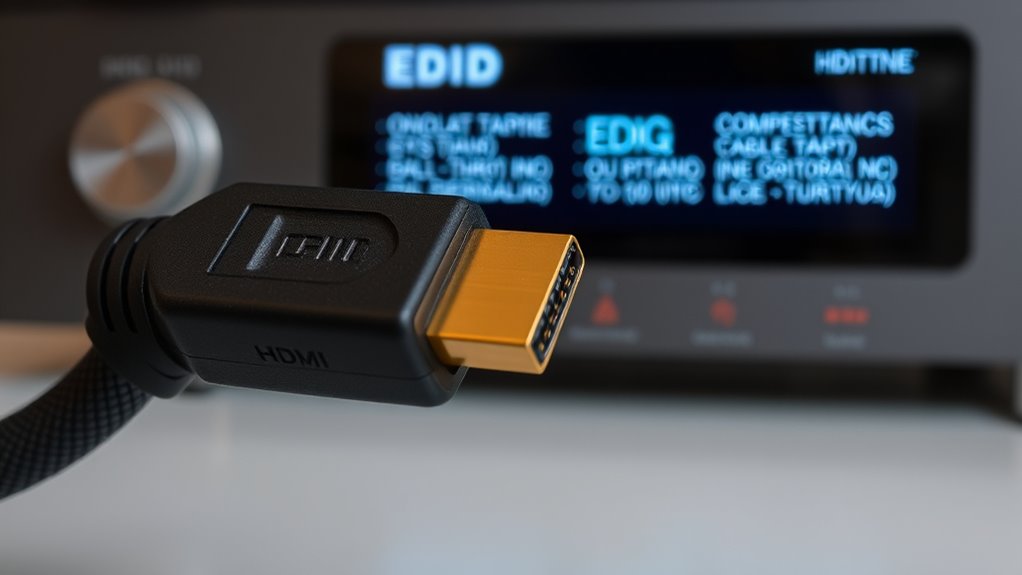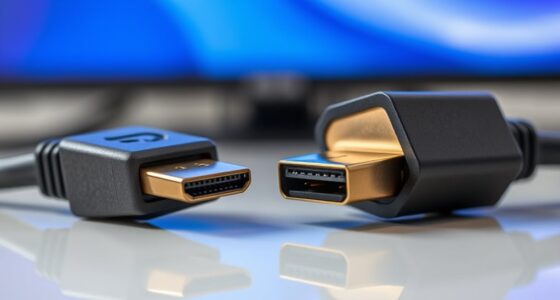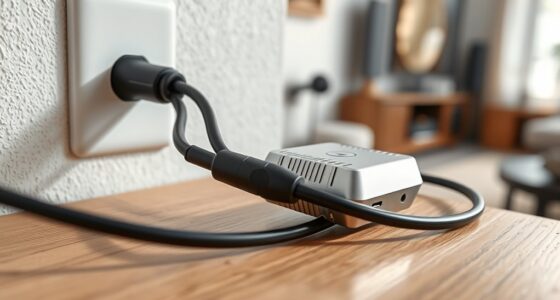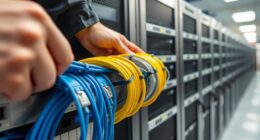When choosing an HDMI cable, understanding EDID helps guarantee your device gets the right image and sound quality. EDID data communicates your display’s supported resolutions, refresh rates, and features to the source device. Using a high-quality cable with sufficient bandwidth, like HDMI 2.1, ensures the signal matches what your display needs, preventing issues like no picture or flickering. Keep in mind, the right cable depends on your EDID details—learn more to optimize your setup.
Key Takeaways
- HDMI cables must support the bandwidth requirements specified by the display’s EDID for optimal resolution and features.
- Higher-resolution displays, like 4K or 8K, require cables with sufficient bandwidth as indicated by EDID data.
- Using cables that meet or exceed the EDID’s supported standards prevents signal loss and ensures compatibility.
- Proper cable selection aligns with EDID information to enable features like HDR, high refresh rates, and audio formats.
- Incompatible or low-quality cables can cause issues if they don’t support the bandwidth and specifications communicated via EDID.

Understanding EDID (Extended Display Identification Data) is essential when working with HDMI connections. EDID is the information your display sends to your source device, such as a computer or media player, to communicate its capabilities. This data includes details about supported resolutions, refresh rates, color depths, and audio formats. Knowing how EDID works helps you select the right HDMI cables and devices to guarantee superior performance. When considering HDMI standards, it’s important to understand that each version — from HDMI 1.4 to HDMI 2.1 — supports different features and resolutions. These standards define the maximum bandwidth, pixel formats, and audio options available. Your display’s EDID configuration informs the source device what it can handle within these standards, preventing issues like compatibility errors or poor image quality. Additionally, accurate EDID data ensures optimal performance by enabling your devices to communicate effectively and utilize the full capabilities of your setup. In practical terms, EDID configurations are like a set of rules that dictate what your display can do. If the EDID data isn’t accurate or is incompatible with your source device, you might experience problems such as no picture, flickering, or limited resolution. This is especially relevant when connecting high-resolution displays or multiple devices. For example, a 4K TV with a detailed EDID profile will tell your computer or gaming console that it can handle 4K at high refresh rates, allowing you to enjoy crisp images and smooth gameplay. Conversely, an outdated or incorrect EDID might restrict the display to lower resolutions, even if your device and cable support higher ones. Choosing the right HDMI cable also depends on understanding EDID and HDMI standards. High-quality cables with sufficient bandwidth are necessary to transmit the data defined by your display’s EDID. For instance, HDMI 2.1 cables are designed to support the increased bandwidth needed for 8K resolutions and advanced features like variable refresh rate (VRR). Additionally, knowing about EDID configurations helps when troubleshooting connection issues. If your display isn’t displaying properly, checking the EDID data can reveal whether your source device is correctly recognizing the display’s capabilities or if a cable or device needs an upgrade.
Frequently Asked Questions
How Does EDID Affect Audio Transmission Over HDMI?
EDID affects audio transmission over HDMI by informing your device of supported audio formats, which helps with audio calibration and guarantees ideal sound quality. If the EDID data indicates limited audio options, you might experience reduced sound quality or missing features like surround sound. To get the best audio, choose HDMI cables that support high-bandwidth audio signals and ensure your devices correctly interpret the EDID data for seamless sound performance.
Can EDID Settings Be Manually Adjusted on All HDMI Devices?
You can’t manually adjust EDID settings on all HDMI devices; many rely on automatic detection to guarantee compatibility. However, some professional equipment allows manual configuration of EDID, giving you control over display capabilities. If your device supports manual configuration, you’ll find options in the settings menu. Otherwise, it automatically detects the EDID from connected devices, making manual adjustments unnecessary for most consumer devices.
What Are the Common Issues Caused by Incompatible EDID Configurations?
Poor pairing causes persistent problems, primarily resolution mismatch and signal dropout. When EDID configurations clash, your device might display incorrect resolutions or lose signals altogether. You might notice flickering screens or blank displays, frustrating your viewing experience. To prevent this, make sure your devices communicate properly, matching their EDID settings. This proactive approach minimizes mismatched resolutions and signal dropouts, keeping your entertainment smooth and seamless.
How Do HDMI Version Differences Impact EDID Data Exchange?
HDMI version differences impact EDID data exchange by affecting compatibility and feature support. Newer HDMI versions offer enhanced capabilities, but older devices may struggle to interpret updated EDID data properly. You should verify your devices have compatible HDMI standards and keep firmware updates current, as they improve HDMI compatibility and EDID handling. This helps maintain seamless communication between devices, preventing signal issues and maximizing your connection’s performance.
Is EDID Information Stored Permanently or Needs Updating?
EDID information is stored permanently in your device’s memory, so it doesn’t need frequent updating. However, if you change your display or upgrade equipment, updating the EDID data can improve compatibility and performance. Some devices support manual or automatic updates, but in most cases, your device retains the EDID data permanently. Just verify your system recognizes new hardware to keep everything running smoothly.
Conclusion
Understanding EDID and HDMI helps you choose the right cable for your setup. Imagine upgrading your home theater only to realize your new 4K TV isn’t displaying as expected because of incompatible cables. By selecting one that supports your device’s EDID info, you guarantee crystal-clear images and seamless sound. Don’t let technical details hold you back—know what to look for and enjoy a truly immersive viewing experience.









